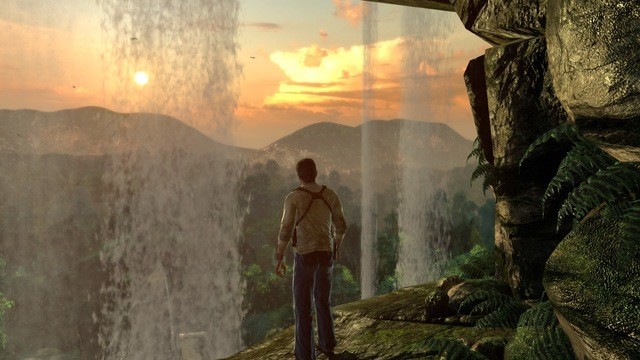Nathan Drake came to embody Sony’s console doctrine – a sarcastic, witty, and charming lead. Drake would fit within the cartoon realms of Ratchet, Clank, Jak, Daxter, Sly Cooper, and others. His creation teases Microsoft’s SpikeTV-esque, gruff-spoken masculinity. Microsoft’s Master Chief and Marcus Fenix may well be brothers in the downtrodden.
Lara Croft’s British pompousness did not carry the same appeal as Indiana Jones. Nathan Drake does. Suddenly, the interactive side of artifact-nabbing and subsequent close calls had a sarcastic blockbuster clone, but one willing to engage with the idiocy prevalent within: massive concrete monuments which still work after thousands of years; somehow still-undiscovered myths which cut a path hundreds of miles wide in forests; legions of thugs who can athletically climb and shimmy with the grace of a young 20-something; expository dialog stuffed with surprise discoveries.
I Need a Hero; I’m Holding Out for a Hero to End of the Night
What’s interesting is how Drake may be the villain of his own series. Unlike his theatrical progenitor, who punches indefensible Nazis in the early days of WWII, Nathan Drake ceaselessly murders those in a contemporary time. Between three games, the number rises to over a thousand lives ended in a search for wealth or personal gain. Drake shoots, people die. It’s normal to him. Rational concern is discarded for complacency. Uncharted refuses to provide necessary context. In all of the series’ well-groomed, brain-at-the-door entertainment spectacles, killing exists because it’s what video games do.
Even in circumstances where Drake is meant NOT to kill, he does.
Underneath a series which otherwise shows an unusual knowledge for cinema’s editing, form, and narrative flow, it still reveals bone-headed contextual simplicity. Even in circumstances where Drake is meant NOT to kill, he does. Sneaking through a museum in the opening chapter of Uncharted 2, the “hero” slings an innocent museum guard from a roof to his death in the ocean below. Drake’s thieving partner makes a funny quip rather than acknowledge the loss of innocent life. Death is covered by an affable personality and showmanship.
Reality is often too difficult for this medium to confront. Then again, Uncharted’s goofiness may not be the proper discussion space. In three games – four counting the Vita’s Golden Abyss – Uncharted never addresses Drake’s special ops-esque gun use. He’s American. Apparently it comes natural at birth.
Wow Factor
From the rather plain jungle-hunting original to the set-piece driven sequels, Uncharted has the capability to “wow”. It’s so easy to be taken in by technical splendor. That’s okay. Sony built and marketed PlayStation 2 on the premise of an “emotion” engine, believing empathy and feeling would be created by a chipset instead of storytelling. The logic was inherently faulty. While Sony’s other series tried, Uncharted is the one-generation-late realization of that punchy marketing angle.
Scenarios across Uncharted construct a determined character who, when close to the people who matter to him, flexes legitimate feelings. Superficial or not, Drake is likeable as a lead. Banter is sharp, wit is high, and comedic timing is precise.
Puny and superficial as death seems in an era of checkpoints and restarts, building tension with the knowledge that Nathan Drake cannot be killed is an admirable attribute. The same way that Jeff Goldblum’s character will never plummet to his death while hanging from a trailer in Lost World: Jurassic Park, Drake will endure while dangling cliffside from a derailed train. The key is instilling a “just maybe” sense of doubt. Uncharted 2 uses loose pipes, the vocal nature of strained metals, and ever-loosening screws. Their use and placement is superlative, genuine in their drama. In comparison, countless arenas primed for predictable shoot-outs become arbitrary. Escaping near death proves spectacular.
Third Down and a Fumble
For the scaled up inroads made by Uncharted 2, Uncharted 3 becomes a bogus imposter. While 2 dodged some gamification (as much as is allowed in mega-budget, first-party spaces) the third is a collapse of those ideals. Drake bar-brawls against muscular, seven-foot giants with inexcusable repetition. Brandished scale is needless – an admittedly delectable, sinking shipyard escape is wholly disconnected from narrative purpose. As it closes on references to David Lean’s desert beauty in Lawrence of Arabia (too near to self-referential, in-joke satire), Uncharted 3 is too far gone to care, even if some of the survivalist splendor is the series’ peak.
“Explore Nathan Drake’s work with cleaner, less smeary textures and more resolution.” Not as succinct, but truthful.
Now all of this is in HD. Or true HD. Or, whatever marketing formality Sony boasts.
“Explore Nathan Drake’s work with cleaner, less smeary textures and more resolution.”
Not as succinct, but truthful. Then, an unneeded frame rate boost which makes Uncharted feel less like the films its copping from and more like a cheap documentary. Choices like this resign video games to their own technical oblivion. It happened to Halo, too.
Whatever the case, each Uncharted carries the same flow, opening with dripping optimism, instilling Drake’s doubt as stakes become concerning, then falling into reassured, theatrical heroics to save Earth. Maybe that’s why Drake gets away with murder – he saves us all, even if his proof will sink into the planet’s core at each end. Uncharted 11: Drake’s Pre-Trial. It would still sell.










Published: Oct 17, 2015 07:08 am